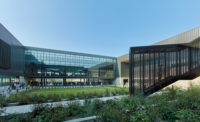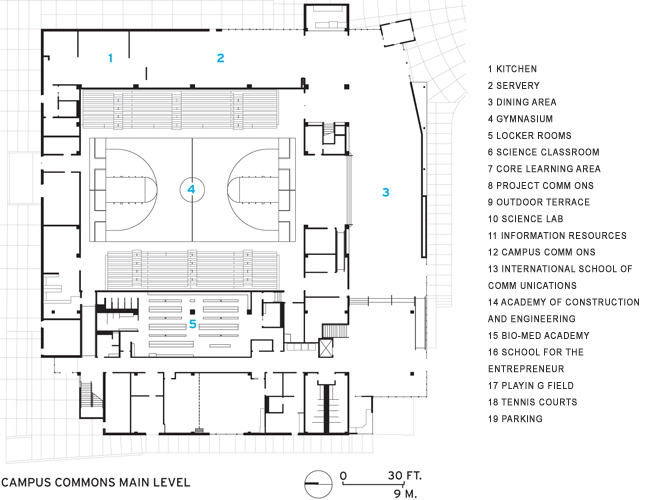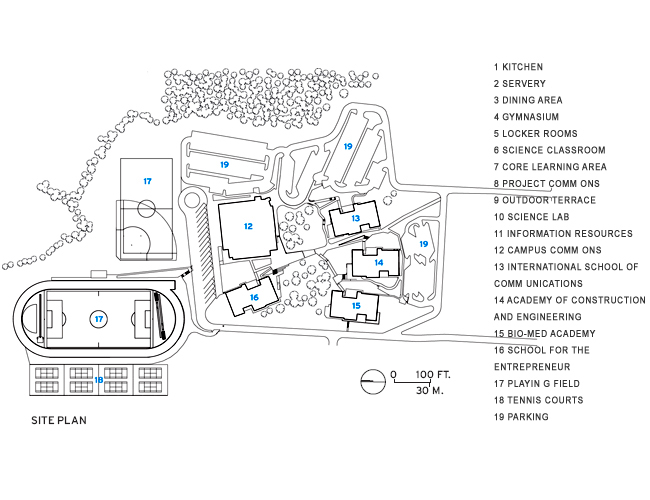Marysville Getchell High School Campus
Divide and Conquer: In a district plagued by years of bond failures and overcrowding, a high school initiates a fresh start with collegiate learning tracks and a complementary campus.
















Architects & Firms
Marysville, Washington
On a misty Pacific Northwest morning, teenagers quickly shuffle along raised boardwalks among five school buildings with hovering roofs vaguely evocative of the bungalows common to the West Coast. Adjacent to a suburban development, the campus, tucked into the tall firs and hemlocks of a second growth forest, makes Marysville Getchell High School in Marysville, Washington, feel more like a college than a high school. Sixteen-year-old senior Louie Vital says, “It makes me feel mature in a setting like this.”
Before Marysville Getchell opened in the fall of 2010, the 11,000-student district had four high schools, including Marysville Pilchuck High School. Pilchuck was built in 1971 for 1,850 students, and by the mid-2000s it was bursting with 3,000. “It's hard for a principal to focus on instruction while managing a small city,” says superintendent Larry Nyland. In 2006, the school board voted to create Small Learning Communities (SLCs) to organize the overcrowded Pilchuck. These offer academic tracks based on specific interests like science or languages. But the small academies struggled to find coherence. Happily, the district passed a bond in 2006 to build a new high school. The Seattle office of DLR Group designed a campus that would accommodate the SLCs and 1,600 pupils in grades 9–12. There are four SLCs at Marysville Getchell, each with its own building: School for the Entrepreneur, Bio-Med Academy, Academy of Construction and Engineering, and International School of Communications. The Campus Commons contains a gym, dining room, and fitness room that puts most health clubs to shame.
The buildings' identities are transmitted through bright-colored accents and subtle graphics. Structures rise from masonry bases, while exposed steel beams and abundant windows create levity. The expansive windows also mean that students and teachers have constant views—of the woods and of one another. Exteriors are clad in aluminum, fiber cement, and high-efficiency glass. Forest shade and operable windows replace a mechanical cooling system.
Craig Mason, DLR's principal in charge of design, has been designing schools for 20 years. Working with the community and a design committee made up of school and district administrators, teachers, and parents, he and his team developed flexible learning spaces that don't respond to a particular curriculum, but instead support the district's five guiding principles, including “relationships at the center,” “community,” and “accountability.” Classrooms with moveable walls are set around common areas for research, projects, interdisciplinary work, and interaction. There are no hallways. Some classrooms remain empty, and outdoor patios can be enclosed if necessary; there's room to grow. Says Mason, “Almost every school we work with is looking at how you change classroom instruction,” which informs classroom design. “It's not a stand-and-deliver anymore.” On the ground floor of each SLC, a social commons abuts a specialized learning area. At the International School of Communications, students produce a daily newscast that airs on a local television channel. In the Academy of Construction and Engineering, the woodshop is on display.
While students played ping-pong during lunch in the Academy of Construction and Engineering, social studies teacher Frank Monkman discussed the transformation of the community after its move from Pilchuck, which is still in use but benefits from a smaller student body. “There are some tougher kids here [in Construction and Engineering], kids who would have dropped out of high school. They were marginalized in a larger school, and now they have accomplishments on their résumé they wouldn't have had,” he says.
Eighth graders who choose an SLC at Marysville Getchell and are unhappy after their freshman year can often switch to a different SLC for their second. “We don't get a lot of changes,” says Nyland, even when students aren't thrilled with their choices. When asked why not, Nyland says that the students report, “The teachers know who I am.”
So far, the school has been met with excitement. Graduation rates district-wide have improved, from 50 percent in 2007 to a projected 89 percent in 2011. Still, some challenges remain. Vital pointed out the difficulty in creating a sense of school-wide community when students are physically segregated. But for the most part, says Nyland, “The comments from the community truly reflect what we wanted to build”—a family atmosphere. “Now principals can put time and attention into building relationships and instruction. The buildings didn't make that happen…” He corrects himself: “But, they did.”
People
Owner:
Architect:
Personnel in architect's firm who should receive special credit:
Dan Munn, PE, SE, LEED AP – Principal in Charge, Engineering
Project Team:
Architect of record:
Interior designer:
Engineer(s): Electrical: Coffman Engineers Civil: SCE, Inc.
Consultant(s): Lighting: Coffman Engineers Acoustical: BRC Acoustics
Other:
General contractor:
Photographer(s):
Renderer(s):
CAD system, project management, or other software used:
Total construction cost: $68 million
Size: 195,000 square feet
Completion Date: August 2010 |
Products
Structural system
Exterior cladding Metal/glass curtain wall: EFCO EIFS, ACM, or other: James Hardy Matrix System Moisture barrier: Cetco Voltex
Roofing Tile/shingles: Owens Corning Asphalt Shingles
Windows
Glazing Skylights: Sunoptics
Doors Fire-control doors, security grilles: Mobilflex
Hardware Closers, Exit devices, Pulls: same as above
Interior finishes Suspension grid: USG (metal ceiling panel) Cabinetwork and custom woodwork: Genothen, LLC Paints and stains: Sherwin Williams Wall coverings: 3M Paneling: Genothen, LLC (birch plywood paneling) Plastic laminate: Formica Special surfacing: Certi-Shine (polished concrete) Floor and wall tile: Daltile, Royal Mosa Resilient flooring: Action Floor Systems, Mondo U.S.A. Carpet: C & A Industries
Furnishings Reception furniture: Kelly, Bank and Office; Millwork by Genothen, LLC Fixed seating: Interkal (stadium seating) Chairs: Kelly, Bank and Office; Virco Tables: Kelly, Bank and Office; Virco Upholstery: Kelly, Bank and Office; Virco
Lighting Downlights: Cooper Lighting, SPI Lighting Exterior: Cooper Lighting Dimming System or other lighting controls: Lutron
Conveyance
Plumbing
Energy |












